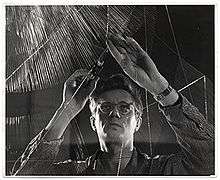Richard Lippold
| Richard Lippold | |
|---|---|
 Lippold working on a sculpture, circa 1950 | |
| Born |
May 3, 1915 Milwaukee, Wisconsin |
| Died | August 22, 2002 (aged 87) |
| Nationality | American |
| Known for | Sculpture |
Richard Lippold (May 3, 1915 Milwaukee, Wisconsin – August 22, 2002) was an American sculptor, known for his geometric constructions using wire as a medium.
He studied at the University of Chicago, and graduated from the School of the Art Institute of Chicago in industrial design in 1937.[1] Lippold worked as an industrial designer from 1937 to 1941. After he became a sculptor, Lippold taught at several universities, including Hunter College at the City University of New York, from 1952 to 1967.
The Lippold Foundation is laboriously maintaining his work. Howard Newman:
Lippold was an engineering genius, but we’ve been dealing with a piece that had reached the threshold of catastrophe,...People’s mouths fall open when they see it going back up, like they’re watching a spider spin a web of blazing gold,...“The more that goes up, the more exquisite it gets.[2]
The 14th and 15th of John Cage's famous Sonatas and Interludes for prepared piano are subtitled Gemini - after the work of Richard Lippold.
Works
- "Ad Astra," at the National Air and Space Museum in Washington, DC
- "Aerial Act," at the Wadsworth Atheneum in Hartford, Connecticut
- "Orpheus and Apollo," at Avery Fisher Hall at Lincoln Center in New York City,[3]
- "Radiant I", at the Inland Steel Building in Chicago, 1957[4]
- "Sun," at the Metropolitan Museum of Art in New York City, which includes more than two miles of gold wire
- "World Tree," within the Walter Gropius-designed Harvard Graduate Center at Harvard Law School in Cambridge, Massachusetts.[5]
- "Fire Bird" at the Segerstrom Center For The Arts in Costa Mesa, California
- Ex Stasis at Marquette University in Milwaukee, Wisconsin
- "Wings of Welcome" at the Hyatt Regency Milwakee
References
- ↑ Encyclopædia Britannica. "Richard Lippold (American sculptor) - Britannica Online Encyclopedia". Britannica.com. Retrieved 2010-07-29.
- ↑ "Wired: Preserving the Installations of Richard Lippold", The New York Times, EVE M. KAHN, January 8, 2009
- ↑ http://www.pencil-of-nature.net/artman/uploads/2003-08-13-01_orpheus.jpg
- ↑ Joan Marter. The Grove Encyclopedia of American Art, (Google Books link), Oxford University Press, 2011, pp. 172-73, (ISBN 0195335791), (ISBN 9780195335798).
- ↑ "HLS HLS Walking Tour: Harkness Graduate Center". Law.harvard.edu. 2005-02-15. Retrieved 2010-07-29.
External links
- Lippold in the Columbia Encyclopedia
- Marika Herskovic, New York School Abstract Expressionists Artists Choice by Artists, (New York School Press, 2000.) ISBN 0-9677994-0-6
- The 1959 Chateau Mouton Rothschild Label by: Richard Lippold
- Richard Lippold "Shapes of the New Sculpture" The Baltimore Museum of Art: Baltimore, Maryland, 1964 Accessed June 26, 2012
This article is issued from Wikipedia - version of the 11/3/2016. The text is available under the Creative Commons Attribution/Share Alike but additional terms may apply for the media files.